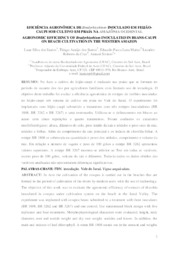Eficiência agronômica de Bradyrhizobium inoculado em feijão-caupi sob cultivo em praia na Amazônia Ocidental.
Eficiência agronômica de Bradyrhizobium inoculado em feijão-caupi sob cultivo em praia na Amazônia Ocidental.
Author(s): SANTOS, L. S. dos; SANTOS, T. A. dos; MATTAR, E. P. L.; CRUZ, L. R. da; SIVIERO, A.
Summary: No Acre o cultivo do feijão-caupi é realizado nas praias que se formam no período de vazante dos rios por agricultores familiares com limitado uso de tecnologia. O objetivo deste trabalho foi avaliar a eficiência agronômica de estirpes de rizóbios inoculadas no feijão-caupi sob sistema de cultivo em praia no Vale do Juruá. O experimento foi implantado com feijão caupi submetido a tratamento com três estirpes inoculadoras (BR 1808, BR 3262 e BR 3267) e uma testemunha. Utilizou-se o delineamento em blocos ao acaso com cinco repetições e quatro tratamentos. Foram avaliados os caracteres morfofisiológicos: altura, diâmetro do colo, peso úmido da raiz e nódulos e peso seco da raiz, nódulos e folhas. Além do comprimento da raiz principal e os índices de clorofila foliar. A estirpe BR 1808 se sobressaiu na quantidade e pesos dos nódulos, comprimento e volume da raiz. Em relação a número de vagens e peso de 100 grãos a estirpe BR 3262 apresentou valores superiores. A estirpe BR 3267 mostrou-se inferior ao Test em todas as variáveis, exceto peso de 100 grãos, volume da raiz e diâmetro. Todavia todos os dados obtidos das variáveis analisadas não apresentaram diferenças significativas. In Acre the cultivation of the cowpea is carried out in the beaches that are formed in the period of cultivation of the rivers by modern users with the use of technology. The objective of this work was to evaluate the agronomic efficiency of extracts of rhizobia inoculated in cowpea under cultivation system on the beach in the Juruá Valley. The experiment was implanted with cowpea beans submitted to a treatment with three inoculants (BR 1808, BR 3262 and BR 3267) and one control. Use randomized block design with five replicates and four treatments. Morphophysiological characters were evaluated: height, neck diameter, root and nodule weight and dry root weight, nodules and leaves. In addition, the main and indexes of leaf chlorophyll. A strain BR 1808 stands out in the amount and weights of root nodules, length and volume. In relation to number of vacancies and weight of 100 grains, BR 3262 presented higher values. A strain BR 3267 was inferior to the test in all the varieties, except weight of 100 grains, root volume and diameter. All data of the analyzed variables should not be respected.
Publication year: 2019
Types of publication: Paper in annals and proceedings
Unit: Embrapa Acre
Keywords: Acre, Agronomic traits, Amazonia Occidental, Amazônia Ocidental, Bactéria, Bradyrhizobium, Características Agronômicas, Caupi, Comunidade Praia Grande, Cowpeas, Cropping systems, Cruzeiro do Sul (AC), Cultivo em praia, Feijão de Corda, Fijación del nitrógeno, Fixação de Nitrogênio, Inoculación de la raíz, Inoculação Artificial, Nitrogen fixation, Raiz, Root inoculation, Sistema de Cultivo, Vigna Unguiculata, Western Amazon
Observation
Some of Embrapa's publications are published as ePub files. To read them, use or download one of the following free software options to your computer or mobile device. Android: Google Play Books; IOS: iBooks; Windows and Linux: Calibre.
Access other publications
Access the Agricultural Research Database (BDPA) to consult Embrapa's full library collection and records.
Visit Embrapa Bookstore to purchase books and other publications sold by Embrapa.

